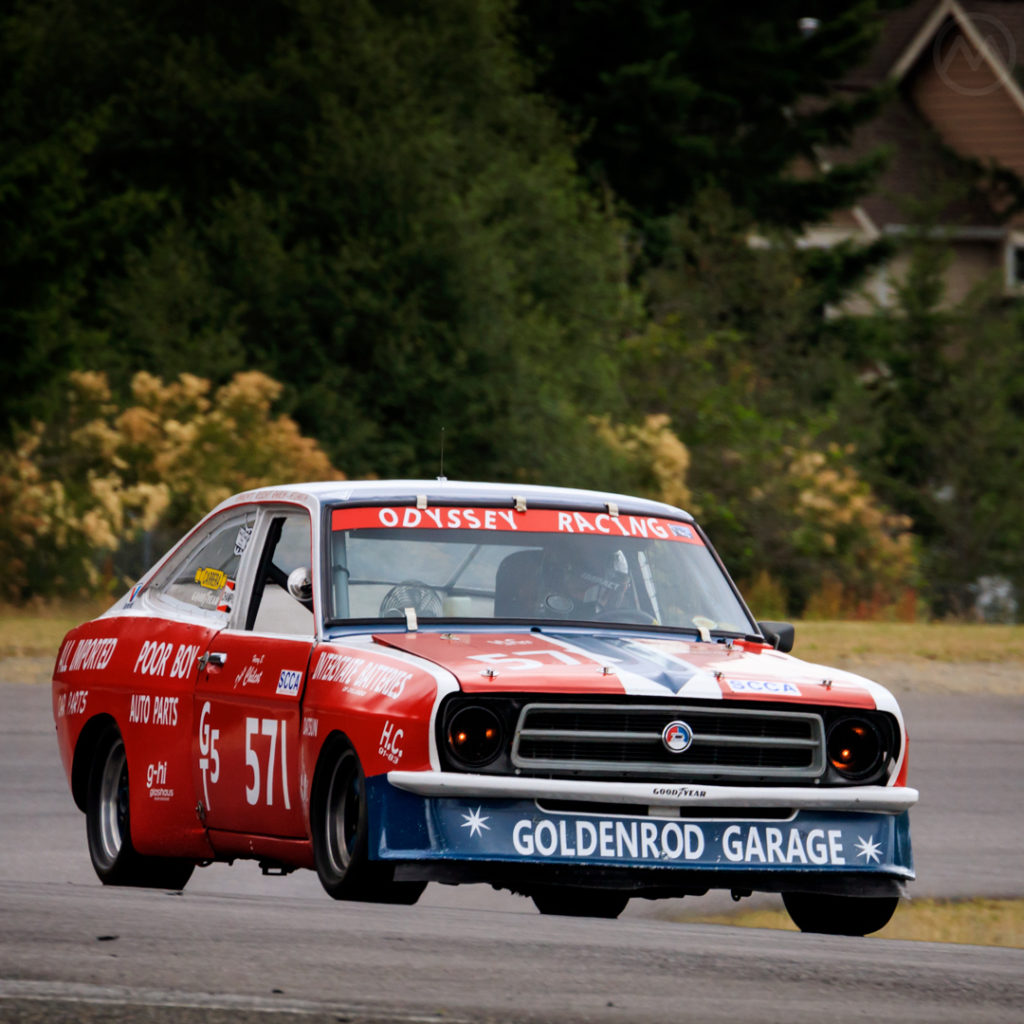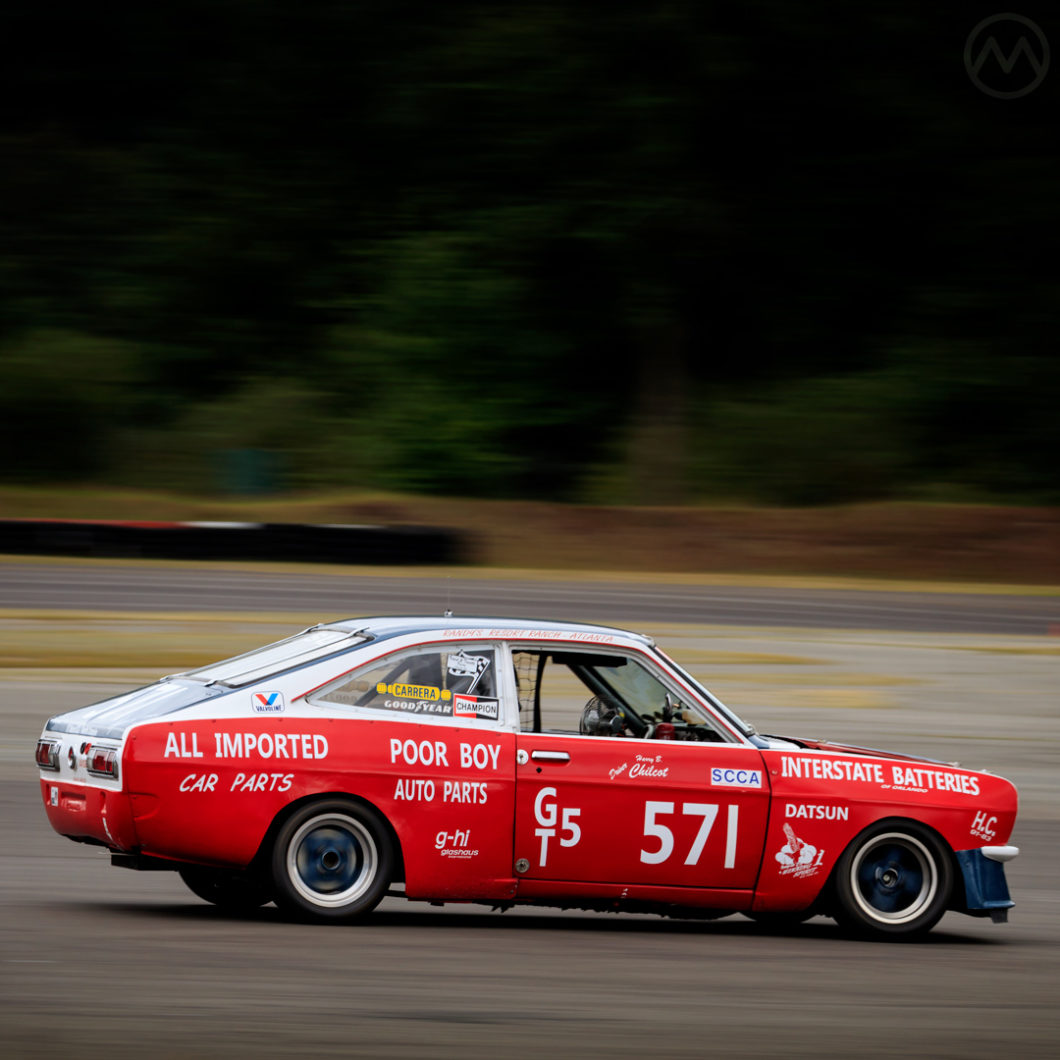For most buyers, the Datsun 1200 had but one purpose – economy. The 1200, known elsewhere as the B110 Sunny, was a bottom-feeder addition to the U.S. Datsun lineup for the 1971 model year and for some of its short two-and-a-half year run, it was the most economical car on sale in the USA.
But one look at the spec sheet and savvy racers could tell the car had real potential.
The smooth OHV 1,171-cc four made just 70hp, but the fastback coupe weighed just 1,609 lbs. The 2-door sedan weighed about 20 lbs. less. It had standard front discs, a precise all-synchro four-speed, it handled well, and it didn’t break easily.
On top of all that, it was cheap. 20% less than a 510, already a popular racer and a car that competed in larger classes. At the time the 1200 was becoming known to American buyers, the 510 was slaying giants in Trans-Am competition.
The 1200 was small enough to compete with MG Midgets and Triumph Spitfires in smaller classes and could offer the car the same kind of image boost. It was ripe for racing modification, and it proved to be a very successful racer long after it left the showroom.
Dick Roberts & the Datsun 1200
One of the earliest 1200 racers was built by Datsun privateer George Eickhoff. Datsun liked the car so much, the stateside competition department, under the direction of Dick Roberts, decided to use it as a basis for a modification program for other privateers. This car, the development car itself, was driven to many poles and wins in SCCA C-production racing in 1973.
Roberts, who formerly raced a Porsche, was an early adopter of Datsuns. Just five years earlier, he’d bought a Datsun 1600 and hauled it around the country for an entire year – racking up good positions and wins and more than 30% of the prize money awarded by Datsun to privateers that year.
His dedication brought him to the attention of Datsun’s national service manager, Lee Wiley, who hired him to head the competition department. That sounds flashy, but remember that in 1968 Datsun was still a small presence in the USA. But racers had always been attracted to foreign cars and racing success still mattered in the showroom. Roberts’ job was to make it easy for Datsun customers to race, and that he did with elan.
Roberts role in Datsun’s competition success is not as well known as those of Pete Brock (whose Brock Racing Enterprises/BRE team was the most successful Datsun outfit around) or Dealer/Racer Bob Sharp (who gave Datsun its first national SCCA championship in 1967, the same year Roberts started with Datsuns).
Nevertheless, he was a crucial player for Datsun’s competition efforts.

Roberts set about making performance parts and performance advice easy to get from the dealer, and even if the dealer didn’t know about setting up your car his five-employee department was only a phone call away. In the early 1970s, when Datsun’s taste for competition success was at its height, the department was helping hundreds of amateur racers around the country. Each success helped raise the profile of the showroom cars.
Eickhoff’s own Datsun 1200 was used as the basis for an ambitious program to conquer SCCA C-sedan competition and conquer it did. The modifications were intentionally mostly bolt-on, and sometimes used pieces from other Datsun cars – modified 240Z brake calipers, for example. In 1973, the department published a manual on how to replicate the Eickhoff car on a D-I-Y basis.
The Racers
By the time the manual was published the little fastback was cleaning up in C-sedan, with racer Don Devendorf winning the national championship at Road Atlanta. This was to be the first of seven consecutive C-sedan championships for Datsun, though they weren’t all with Devendorf at the wheel.
Devendorf was a former BRE racer and repeated his success in 1974 and 1975, but by then he was using the newer Datsun B-210 (the B210 Sunny in other markets). Devendorf’s success gave him entree to Datsun’s American execs, and it was he who convinced Nissan to fund an IMSA program, which they did to great public success.
The 1200’s achievements were not confined to the USA, either. In Australia and New Zealand, the car became a popular and successful rally car – light and chuckable and easy to control. These markets got additional body styles and a locally produced twin-carb SSS version (similar to the sporty Bluebird SSS/510) was offered there. The cars did well on the track and the special stage.
Used Cars
The 1200’s sales run in the USA ended in mid-1973 with the arrival of the next-gen Sunny, the previously-mentioned B-210. This car was even more popular than the 1200 had been, owing in part to its arrival on the eve of the OPEC crisis. But it was also instantly popular as a race car, effectively replacing the earlier 1200s for top-tier racers.
Old race cars don’t die, however, and long after Devendorf and other privateers campaigning current models had left the 1200 behind, it was still winning races.
The ex-Eickhoff/Devendorf car won the C-sedan class of the Washington DC area SCCA and Mid-Atlantic Road Racing Series (MARRS) championships in 1979 with William O. Hagerty at the wheel. Hagerty campaigned the car again in 1980 before eventually selling it on to Harry Chilcot who campaigned it to great success in SCCA’s southeast division into the mid-1980s.
The car is today owned by Washington State vintage racer John Levitt.

